|
|

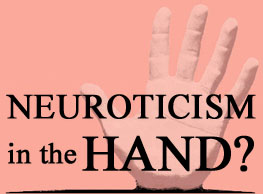
|
"It cannot be denied that people with an abnormally high inhibitive factor are more prone to neurotic disturbances than the opposite type of person, and for this reason psychologists deal more often with the strongly inhibited personality ..." |
| "... Apart from general characteristics, such as the shape and the muscular development of the hand, the factor of inhibition can be seen als in the crease-line system, and, up to a point, in the physical qualities of the hand. ... One of the prinicipal characteristics of the sensitive types of hands is the great number of broken creas-lines and their superficial design. There are also more broken creases and other faults of design in these hands than in other hand-types, and both of these characteristics are significant for a strong inhibitive factor." |
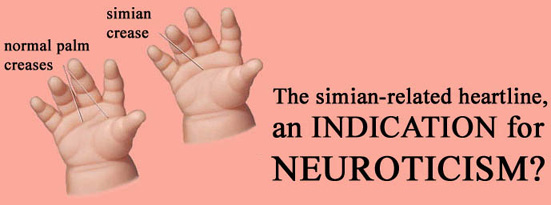
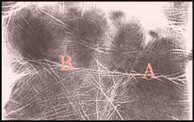 |
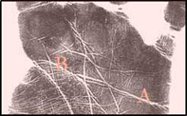 |
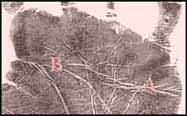 |
The Big Five scores of 15 subjects who
have a simian-related heartline
By means of the NEO PI-R questionnaire the Big Five profiles of 13 Dutch subjects with a simian-related heart line have been measured. By the way, these subjects were all participants in my Master-thesis study or the follow-up study.
The percentages in the above figure indicate that the Big Five scores of the women show only on the dimension NEUROTICISM a clear deviation from the expected 'normal' scores. A likewise relation is seen in the figure below regarding the Big Five scores of the men with a simian-related heart line. However, the scores of the men show also a significant deviation on the dimension Extraversion.
REFERENCES:
The figures below show the Big Five scores of a sample of in respective 9 women and 4 men. The dotted lines in the figures show the expected percentages taken from the manual of the NEO PI-R questionnair. Every single Big Five dimension is expected to show a 'normal' distribution: 22% scoring 'low' (score:
1, 2 or 3), 56% scoring 'normal' (score: 4, 5 or 6), and 22% scoring 'high' (score 7, 8 or 9).

A simian-related heart line appears to be accompagnied frequently with a high score on the dimension NEUROTICISM, in both the studied men and women. When the results of both sexes are considered together the overall result on the dimension NEUROTICISM is significant at: p<0.005 (according the Pearson ksi-square test). 61% of the studied subjects with a simian-related heart line score 'high' on NEUROTICISM, while on the basis of a 'normal' distribution a percentage of 22% was expected.
When the results of both sexes are considered together there appears to be a relation as well between the simian-related heart line and a low score on the Big Five dimension Extraversion, significant at: p<0.025 (according the Pearson ksi-square test). But this effect appears to be less strong compared to the results on the Big Five dimension NEUROTICISM.

Finally one can notice that the above mentioned research results confirm the insights regarding the simian line, which have been gathered by scientists over the years. For the results of hundreds of studies indicate that the simian line is frequently accompagnied with various variants of medical pathology. The most well-known example concerns Down's syndrome (5) - this example is frequently observed on the websites of traditional handanalysts. HERE you can find the website of a lady who has a simian line in her left hand; next to her personal thoughts (sometimes quite neurotic) about her simian line does she describe quite a lot of information about the (medical) backgrounds of the siman line.
Combined with these insights on the 'famous' simian line, one can derive from the above described results that the simian-related heart line is not only significant in the perspective of (Big Five) psychology. For in line with the earlier mentioned observation that high scorers on NEUROTICISM have an increased risk for certain forms of psychopathology (depression, generalized fear and agoraphobia were mentioned), it is likely that some day the simian-related heart line might appear to be an indicator for psychopathology as well.
COMPREHENSIVE ARTICLES ABOUT THE SIMIAN CREASE:
• The Simian Line: hand factor 6a in Neuroticism!
• The Simian Line: a notorious hand crease!
• The Simian Line & Down syndrome!
• The Simian Line & fragile-X syndrome!
• Why is the simian line recognized as a 'minor physical anomaly'?
1. Five-Factor Model
2. Hoekstra, H.A. e.a. (1996). NEO PI-R, NEO FFI: Big Five persoonlijkheidsvragenlijsten: handleiding. Lisse: Swets & Zeitlinger Publishers
3. Wolff, Ch. A psychology of gesture. Methuen, 1945.
4. Wolff, Ch. The hand in psychological diagnosis. Methuen, 1951.
5. SYMPTOMS GUIDE: the simian crease
|
|
© COPYRIGHT 2002-2016: |